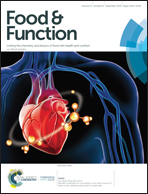In vitro digestibility and release of a mango peel extract encapsulated within water-in-oil-in-water (W1/O/W2) emulsions containing sodium carboxymethyl cellulose
Abstract
Mango peel is a rich source of phenolic compounds (PC), which can be used in food fortification. The use of water-in-oil-in-water (W1/O/W2) emulsions represents a potential strategy to encapsulate, protect and incorporate PC from mango peel into food products. Moreover, even though non-digestible biopolymers are usually incorporated into emulsions to enhance stability, little is known about the effect on the digestibility and release of PC. In this study, a mango peel extract (MPE) was encapsulated using W1/O/W2 emulsions containing sodium carboxymethyl cellulose (CMC; 0, 0.5, 1.0% w/w) in W2, and their colloidal stability, lipid digestibility kinetics (free fatty acid release), and release (in terms of antioxidant activity) under in vitro digestion conditions were evaluated. The presence of CMC in emulsions caused flocculation of droplets, which remained unchanged during the gastric phase, suggesting that bridging flocculation occurred. Moreover, a slower lipid digestion rate was observed in emulsions containing CMC, with k-values ranging between 0.21 and 0.25 min−1, compared to emulsions without CMC (around 0.14 min−1). However, although CMC may slow down the lipolysis reaction during the first 40 min due to physical or steric hindrance, at the end of the intestinal phase, emulsions with or without CMC had a similar final FFA release. Moreover, MPE release was triggered under gastric conditions, probably by osmotic imbalance, showing a constant antioxidant activity value during the intestinal phase only in emulsions containing CMC. This study provides relevant insights to design double emulsions as delivery systems of water-soluble bioactive compounds with antioxidant activity, such as PC.



 Please wait while we load your content...
Please wait while we load your content...